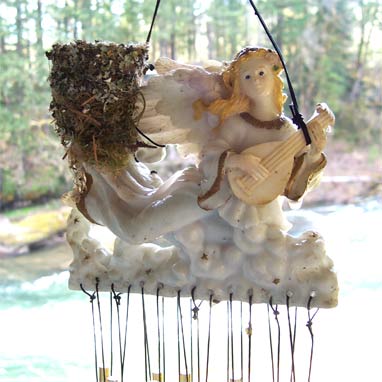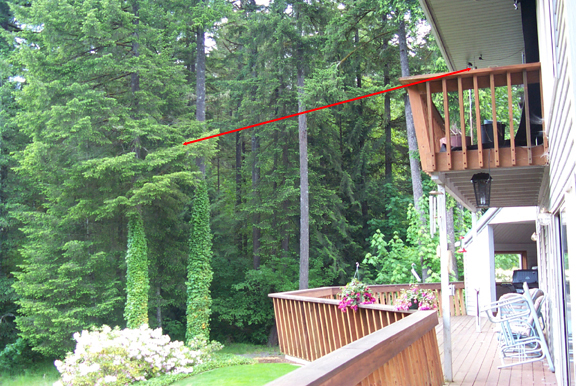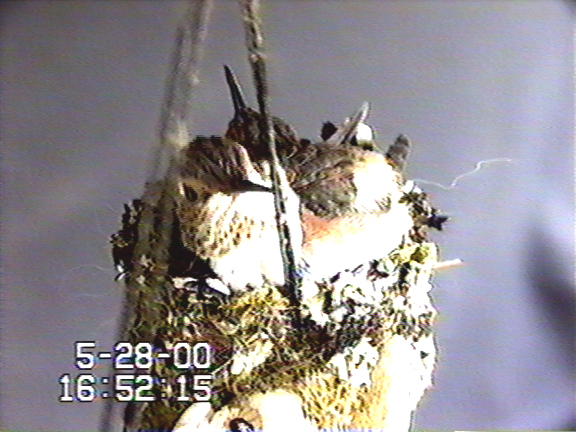
Hummingbird
Camera and Site Info
2000

This is the wind chime where our story begins.
We
first noticed the nest on April 16, 2000. It seemed like such an odd place
to build a nest, but then when you think about it, placing your nest on
the wings of an Angel might be a smart move. Opportunity was knocking and
as I am kind of a technology nut I decided to place a camera so we could
turn on any TV in the house and see what was going on without the possibility of
disturbing the nest building process.. Well, being we both work most of
the time and didn't want to miss out, I decided to design a quick web page and
upload captured images to the site on a timely basis so we could enjoy this
little miracle all day long. Well, I told a few friends about the site, and they
told a few friends and everything just sort of evolved from there. At one
point, the day the babies left the nest, we had 5,558 visitors to the site.
Hard to believe that many people would take the time to see baby hummers lift
off for the first time. We
changed to a different camera on April 18th and noticed that there
was now one egg in the nest. At
this point the Hummingbird was not spending much time on the nest.
On Friday the 21st we noticed the second egg.
At this point she began sitting on the nest most of the time except to
feed and gather more nest building material.
She has built the nest up quite a bit since then and on the 26th
we lowered the wind chime she has the nest built on by about 4” to allow a
better view of the inside of the nest. We
were very careful not to disturb or touch the nest. The females are responsible
for all nest building and raising of the young.
They build their nests out of a variety of materials but mostly out of
downy plant fibers, moss, lichens and spider/insect silk. To conserve energy at
night, Hummingbirds sometimes go into a state of torpor.
Their heartbeat slows to about 50 beats a minute and their breathing
becomes irregular and sometimes they do not breath at all.
Torpor can last form 8 – 14 hours.
They do not do this every night – just when their energy reserves are
very low. Hummingbirds do not suck nectar – they have a tongue, which
laps the nectar. They also eat a
wide variety of small insects and spiders.
We
are pretty sure this female was a Rufous Hummingbird.
According to the book we have, the incubation time of the eggs is not
known. In reading about some of the other species of Hummingbirds,
the incubation period is anywhere from 13 – 19 days. The young will remain in
the nest for about 20 days and then will stay close to the nest for possibly
another 2 weeks or so while the mother still feeds them. The young do not have
to learn how to fly – they will just fly right out of the nest when they are
ready, however, they still may be a little wobbly while perching for the first
few times.
The photo below shows where we spotted the baby hummers. The red line indicates their flight path.
Momma has been feeding them while they perch in the fir tree.


This is one of the last views of the babies before the left the nest.
Click here to see still photos of the little hummers.
Click here to see a video clip of momma feeding the hummers.
Click here to see a video of their Departure.
We hope that you have enjoyed following the progress of the female nesting as much as we did. We will be installing a new and improved color camera for 2001 which will allow a better view of the female, eggs and eventually the young. We have also read that Hummingbirds sometimes nest in the same spot from year to year. We hope this is the case, or an empty nest is all we will get see in 2001. Enjoy!!
Alan & Brenda
![]() Click
here to tell us what you think
Click
here to tell us what you think
 Back
to the camera page
Back
to the camera page